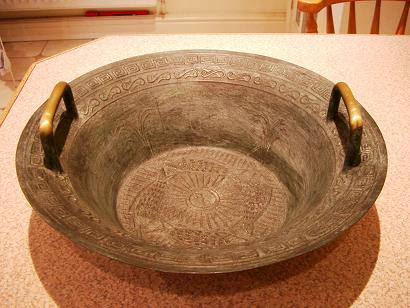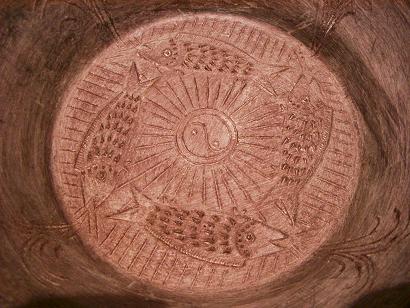An entertaining resonance phenomenon
|
|
|
|
Fig. 16-18a shows a replica bronze washbowl which was used in ancient China. Four fish are cast into the bottom of the washbowl in an anti-clockwise direction around the centre of the base as shown in Fig. 16-18b. The washbowl is symmetric about the plane that passes through the centre of the bowl and is parallel to the two handles. Now, such bowls are used for entertainment, as the water in the washbowl can be made to spurt up to 300 mm into the air around the locations of the fishes' mouths when two hands rub the handles on the washbowl. This effect can be produced as follows:
- The washbowl is filled half full with water and placed on a wet kitchen towel set in the shape of a ring of radius of about 80 mm.
- Clean two hands using soap and water and the palms are used to rub the handles of the washbowl as shown in Fig. 16-18c. The two palms move forward and backward alternatively and periodically, creating a pair of anti-symmetric periodical forces applied to the symmetrically located handles of the washbowl.
- Sound will generate from between the palms and the handles and ripples will form on the water surface (Fig. 16-18c).
- Continuing the hand movements will cause drops of water to jump out almost vertically from locations around the mouths of the fishes. Fig. 16-18d shows the situation when the resonance occurs.
Only small forces are applied to the two handles of the washbowl in the vertical and forward-backward directions. As the hands move periodically, resonance occurs when the frequency of hand movement matches one of the natural frequencies of the washbowl-water system. The evidence of the resonance is sound and 'jumping water'.
Please wait 10 seconds for video autoplaying. Rightclick here to download this video piece.

 a)
Replica bronze washbowl
a)
Replica bronze washbowl b) Four fishes cast into the bottom of the bowl
b) Four fishes cast into the bottom of the bowl  c) Ripple on water surface
c) Ripple on water surface d) Water jumping out vertically
d) Water jumping out vertically